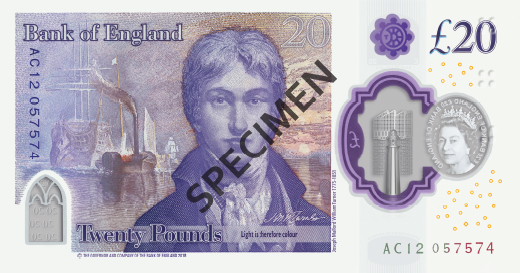Are you ready for the new ‘plastic’ £20 note arriving later this month?
The new and smaller polymer note will be introduced on Thursday February 20th – that’s £20 on 20.02.2020. Laden with built-in security features, it will gradually replace the existing ‘paper’ £20 note, which is Britain’s most used and most forged banknote. It will join the now familiar polymer £5 note (introduced on September 13th, 2016) and £10 note (introduced on September 14th, 2017).
.jpg?h=273&la=en&w=520&hash=0B44F7DD41E6DD6F1EDF24650C9EA6CE59217A4F) Like its lower denomination stablemates, the new £20 note will be made of a hardwearing and durable polymer plastic designed to last much longer than traditional ‘paper’ banknotes (actually made from a kind of linen). And just as the new polymer £5 and £10 notes are smaller than their predecessors, the new £20 note will also be slightly smaller than the current one. It will measure 139mm by 73mm – a centimetre less in width and 7mm less in height.
Like its lower denomination stablemates, the new £20 note will be made of a hardwearing and durable polymer plastic designed to last much longer than traditional ‘paper’ banknotes (actually made from a kind of linen). And just as the new polymer £5 and £10 notes are smaller than their predecessors, the new £20 note will also be slightly smaller than the current one. It will measure 139mm by 73mm – a centimetre less in width and 7mm less in height.
The design for the new £20 note will feature a portrait of English Romantic artist J.M.W. Turner (1775-1851) – actually a self-portrait from 1799, when he was about 24 years old. It will also feature one of his best-known paintings, “The Fighting Temeraire” – which is on display in the National Gallery. HMS Temeraire played a key part in Nelson’s decisive 1805 victory at Trafalgar and Turner’s artistic tribute to the great warship was voted Britain’s greatest painting in a 2005 poll.
 Turner’s signature on the new £20 note is taken from his will, in which he bequeathed his work to the nation. It also features a quote – “Light is therefore colour” – taken from an 1818 lecture by Turner at the Royal Academy of Arts. Turner’s popularity received a boost through a 2014 movie about his life and work, starring Timothy Spall as the great artist.
Turner’s signature on the new £20 note is taken from his will, in which he bequeathed his work to the nation. It also features a quote – “Light is therefore colour” – taken from an 1818 lecture by Turner at the Royal Academy of Arts. Turner’s popularity received a boost through a 2014 movie about his life and work, starring Timothy Spall as the great artist.
Security features of the new £20 note designed to foil the counterfeiters include:
- A large see-through window, based on the shape of the fountains in London’s Trafalgar Square, with a blue and gold foil on the front depicting Margate lighthouse and the Turner Contemporary gallery in the town
- A smaller see-through window in the bottom corner of the note inspired by Tintern Abbey
- A metallic hologram which changes between the words “Twenty” and “Pounds” when tilted
- The Queen’s portrait in the see-through window with “£20 Bank of England” printed twice around the edge
- A silver foil patch with the 3D image of the Coronation Crown
- A purple foil patch containing the letter ‘T’, based on the staircase at the Tate Britain gallery
- Viewing the front of the note under ultraviolet light, the number 20 appears in bright red and green
- Not a security feature as such, but raised dots in the top left corner of the note will help blind and partially-sighted people identify its value.
Statistics from the Bank of England show the £20 is Britain’s most commonly circulating banknote, with two billion of them in the system. That means it will take quite some time to fully change over from the current £20 note to the new one. Everyone will be able to use the existing paper £20 note (introduced in 2007 and featuring a portrait of economist Adam Smith) alongside the new one until the old note is officially withdrawn from circulation.
The Bank of England will announce the withdrawal date for the old note once the new one is in general circulation. It will give at least six months’ notice of the withdrawal date, allowing people plenty of time to root out their stashes of old £20 notes and get them spent or exchanged.
Even after the withdrawal date, there will be ways to exchange old notes for new ones. For a limited period, people will be able to exchange them in person at their bank or local Post Office, but after that they will need to be sent direct to the Bank of England.
After the new £20 note’s introduction this month, the only remaining paper banknote will be the £50 note, which is Britain’s least used banknote. That is also set to change, with a new polymer £50 note set to enter circulation by the end of 2021. It will feature a portrait of computer pioneer and codebreaker Alan Turing and will measure 146mm by 77mm, slightly smaller than the current paper £20 note.
• You can find out more about the new £20 note by clicking here.
